Zhiqiang Shen
Attention Is All You Need for KV Cache in Diffusion LLMs
Oct 16, 2025Abstract:This work studies how to adaptively recompute key-value (KV) caches for diffusion large language models (DLMs) to maximize prediction accuracy while minimizing decoding latency. Prior methods' decoders recompute QKV for all tokens at every denoising step and layer, despite KV states changing little across most steps, especially in shallow layers, leading to substantial redundancy. We make three observations: (1) distant ${\bf MASK}$ tokens primarily act as a length-bias and can be cached block-wise beyond the active prediction window; (2) KV dynamics increase with depth, suggesting that selective refresh starting from deeper layers is sufficient; and (3) the most-attended token exhibits the smallest KV drift, providing a conservative lower bound on cache change for other tokens. Building on these, we propose ${\bf Elastic-Cache}$, a training-free, architecture-agnostic strategy that jointly decides ${when}$ to refresh (via an attention-aware drift test on the most-attended token) and ${where}$ to refresh (via a depth-aware schedule that recomputes from a chosen layer onward while reusing shallow-layer caches and off-window MASK caches). Unlike fixed-period schemes, Elastic-Cache performs adaptive, layer-aware cache updates for diffusion LLMs, reducing redundant computation and accelerating decoding with negligible loss in generation quality. Experiments on LLaDA-Instruct, LLaDA-1.5, and LLaDA-V across mathematical reasoning and code generation tasks demonstrate consistent speedups: $8.7\times$ on GSM8K (256 tokens), $45.1\times$ on longer sequences, and $4.8\times$ on HumanEval, while consistently maintaining higher accuracy than the baseline. Our method achieves significantly higher throughput ($6.8\times$ on GSM8K) than existing confidence-based approaches while preserving generation quality, enabling practical deployment of diffusion LLMs.
Prompting Test-Time Scaling Is A Strong LLM Reasoning Data Augmentation
Oct 10, 2025Abstract:Large language models (LLMs) have demonstrated impressive reasoning capabilities when provided with chain-of-thought exemplars, but curating large reasoning datasets remains laborious and resource-intensive. In this work, we introduce Prompting Test-Time Scaling (P-TTS), a simple yet effective inference-time data augmentation strategy for enhancing LLM reasoning through finetuning. Rather than collecting thousands or even millions of examples, P-TTS leverages a small pool of only 90 manually selected reasoning instances and systematically varies exemplar augmentation through principled instruction prompting intensities at test time to synthesize diverse reasoning trajectory contexts. Then we finetune the various sizes of Qwen-2.5 models on P-TTS data. Across a suite of mathematical reasoning AIME2024 & 25, MATH500, and GPQA-Diamond, our P-TTS-7B and 32B models outperform the prior competitive baselines like S1 and S1.1 (1K-shot), achieving absolute accuracy gains of +26.66% and +30.00% on AIME'24 (7B), and +13.34% and +6.67% on AIME'25 (7B); P-TTS-32B yields gains of +23.33% and +16.63% on AIME'24, and +26.63% and +3.33% on AIME'25 (vs. S1 and S1.1, respectively), with comparable or better performance on MATH500 and GPQA-Diamond. We further show that P-TTS enhances zero-shot generalization accuracy on out-of-domain reasoning benchmarks of Gaokao, Kaoyan, OlympiadBench, AMC23, GradeSchoolMath, and Minerva. Our analysis suggests that test-time scaling effectively explores the latent space of reasoning patterns, amplifying LLM problem-solving with minimal annotation overhead, and further unlocking the reasoning potential and capabilities of LLMs. Prompting Test-Time Scaling offers a practical, low-cost way to elicit LLM reasoning in resource-constrained or rapidly evolving domains.
SynMatch: Rethinking Consistency in Medical Image Segmentation with Sparse Annotations
Aug 10, 2025Abstract:Label scarcity remains a major challenge in deep learning-based medical image segmentation. Recent studies use strong-weak pseudo supervision to leverage unlabeled data. However, performance is often hindered by inconsistencies between pseudo labels and their corresponding unlabeled images. In this work, we propose \textbf{SynMatch}, a novel framework that sidesteps the need for improving pseudo labels by synthesizing images to match them instead. Specifically, SynMatch synthesizes images using texture and shape features extracted from the same segmentation model that generates the corresponding pseudo labels for unlabeled images. This design enables the generation of highly consistent synthesized-image-pseudo-label pairs without requiring any training parameters for image synthesis. We extensively evaluate SynMatch across diverse medical image segmentation tasks under semi-supervised learning (SSL), weakly-supervised learning (WSL), and barely-supervised learning (BSL) settings with increasingly limited annotations. The results demonstrate that SynMatch achieves superior performance, especially in the most challenging BSL setting. For example, it outperforms the recent strong-weak pseudo supervision-based method by 29.71\% and 10.05\% on the polyp segmentation task with 5\% and 10\% scribble annotations, respectively. The code will be released at https://github.com/Senyh/SynMatch.
ConStyX: Content Style Augmentation for Generalizable Medical Image Segmentation
Jun 12, 2025Abstract:Medical images are usually collected from multiple domains, leading to domain shifts that impair the performance of medical image segmentation models. Domain Generalization (DG) aims to address this issue by training a robust model with strong generalizability. Recently, numerous domain randomization-based DG methods have been proposed. However, these methods suffer from the following limitations: 1) constrained efficiency of domain randomization due to their exclusive dependence on image style perturbation, and 2) neglect of the adverse effects of over-augmented images on model training. To address these issues, we propose a novel domain randomization-based DG method, called content style augmentation (ConStyX), for generalizable medical image segmentation. Specifically, ConStyX 1) augments the content and style of training data, allowing the augmented training data to better cover a wider range of data domains, and 2) leverages well-augmented features while mitigating the negative effects of over-augmented features during model training. Extensive experiments across multiple domains demonstrate that our ConStyX achieves superior generalization performance. The code is available at https://github.com/jwxsp1/ConStyX.
Learning Efficient and Generalizable Graph Retriever for Knowledge-Graph Question Answering
Jun 11, 2025Abstract:Large Language Models (LLMs) have shown strong inductive reasoning ability across various domains, but their reliability is hindered by the outdated knowledge and hallucinations. Retrieval-Augmented Generation mitigates these issues by grounding LLMs with external knowledge; however, most existing RAG pipelines rely on unstructured text, limiting interpretability and structured reasoning. Knowledge graphs, which represent facts as relational triples, offer a more structured and compact alternative. Recent studies have explored integrating knowledge graphs with LLMs for knowledge graph question answering (KGQA), with a significant proportion adopting the retrieve-then-reasoning paradigm. In this framework, graph-based retrievers have demonstrated strong empirical performance, yet they still face challenges in generalization ability. In this work, we propose RAPL, a novel framework for efficient and effective graph retrieval in KGQA. RAPL addresses these limitations through three aspects: (1) a two-stage labeling strategy that combines heuristic signals with parametric models to provide causally grounded supervision; (2) a model-agnostic graph transformation approach to capture both intra- and inter-triple interactions, thereby enhancing representational capacity; and (3) a path-based reasoning strategy that facilitates learning from the injected rational knowledge, and supports downstream reasoner through structured inputs. Empirically, RAPL outperforms state-of-the-art methods by $2.66\%-20.34\%$, and significantly reduces the performance gap between smaller and more powerful LLM-based reasoners, as well as the gap under cross-dataset settings, highlighting its superior retrieval capability and generalizability. Codes are available at: https://github.com/tianyao-aka/RAPL.
Pruning Spurious Subgraphs for Graph Out-of-Distribtuion Generalization
Jun 06, 2025Abstract:Graph Neural Networks (GNNs) often encounter significant performance degradation under distribution shifts between training and test data, hindering their applicability in real-world scenarios. Recent studies have proposed various methods to address the out-of-distribution generalization challenge, with many methods in the graph domain focusing on directly identifying an invariant subgraph that is predictive of the target label. However, we argue that identifying the edges from the invariant subgraph directly is challenging and error-prone, especially when some spurious edges exhibit strong correlations with the targets. In this paper, we propose PrunE, the first pruning-based graph OOD method that eliminates spurious edges to improve OOD generalizability. By pruning spurious edges, \mine{} retains the invariant subgraph more comprehensively, which is critical for OOD generalization. Specifically, PrunE employs two regularization terms to prune spurious edges: 1) graph size constraint to exclude uninformative spurious edges, and 2) $\epsilon$-probability alignment to further suppress the occurrence of spurious edges. Through theoretical analysis and extensive experiments, we show that PrunE achieves superior OOD performance and outperforms previous state-of-the-art methods significantly. Codes are available at: \href{https://github.com/tianyao-aka/PrunE-GraphOOD}{https://github.com/tianyao-aka/PrunE-GraphOOD}.
VideoMolmo: Spatio-Temporal Grounding Meets Pointing
Jun 05, 2025Abstract:Spatio-temporal localization is vital for precise interactions across diverse domains, from biological research to autonomous navigation and interactive interfaces. Current video-based approaches, while proficient in tracking, lack the sophisticated reasoning capabilities of large language models, limiting their contextual understanding and generalization. We introduce VideoMolmo, a large multimodal model tailored for fine-grained spatio-temporal pointing conditioned on textual descriptions. Building upon the Molmo architecture, VideoMolmo incorporates a temporal module utilizing an attention mechanism to condition each frame on preceding frames, ensuring temporal consistency. Additionally, our novel temporal mask fusion pipeline employs SAM2 for bidirectional point propagation, significantly enhancing coherence across video sequences. This two-step decomposition, i.e., first using the LLM to generate precise pointing coordinates, then relying on a sequential mask-fusion module to produce coherent segmentation, not only simplifies the task for the language model but also enhances interpretability. Due to the lack of suitable datasets, we curate a comprehensive dataset comprising 72k video-caption pairs annotated with 100k object points. To evaluate the generalization of VideoMolmo, we introduce VPoS-Bench, a challenging out-of-distribution benchmark spanning five real-world scenarios: Cell Tracking, Egocentric Vision, Autonomous Driving, Video-GUI Interaction, and Robotics. We also evaluate our model on Referring Video Object Segmentation (Refer-VOS) and Reasoning VOS tasks. In comparison to existing models, VideoMolmo substantially improves spatio-temporal pointing accuracy and reasoning capability. Our code and models are publicly available at https://github.com/mbzuai-oryx/VideoMolmo.
Time Blindness: Why Video-Language Models Can't See What Humans Can?
May 30, 2025Abstract:Recent advances in vision-language models (VLMs) have made impressive strides in understanding spatio-temporal relationships in videos. However, when spatial information is obscured, these models struggle to capture purely temporal patterns. We introduce $\textbf{SpookyBench}$, a benchmark where information is encoded solely in temporal sequences of noise-like frames, mirroring natural phenomena from biological signaling to covert communication. Interestingly, while humans can recognize shapes, text, and patterns in these sequences with over 98% accuracy, state-of-the-art VLMs achieve 0% accuracy. This performance gap highlights a critical limitation: an over-reliance on frame-level spatial features and an inability to extract meaning from temporal cues. Furthermore, when trained in data sets with low spatial signal-to-noise ratios (SNR), temporal understanding of models degrades more rapidly than human perception, especially in tasks requiring fine-grained temporal reasoning. Overcoming this limitation will require novel architectures or training paradigms that decouple spatial dependencies from temporal processing. Our systematic analysis shows that this issue persists across model scales and architectures. We release SpookyBench to catalyze research in temporal pattern recognition and bridge the gap between human and machine video understanding. Dataset and code has been made available on our project website: https://timeblindness.github.io/.
Open CaptchaWorld: A Comprehensive Web-based Platform for Testing and Benchmarking Multimodal LLM Agents
May 30, 2025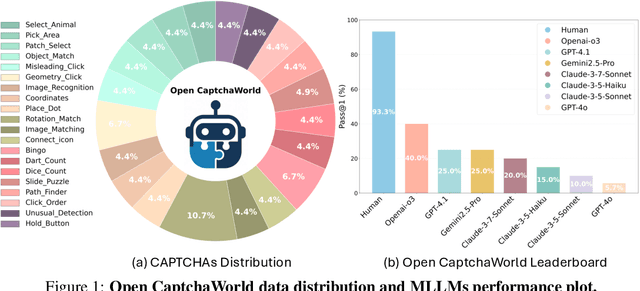
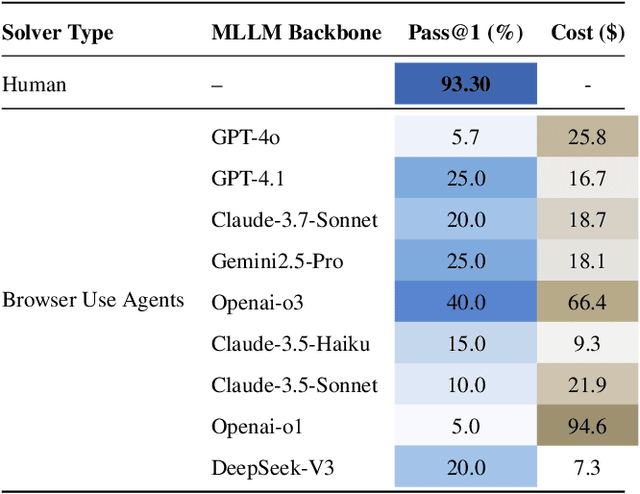
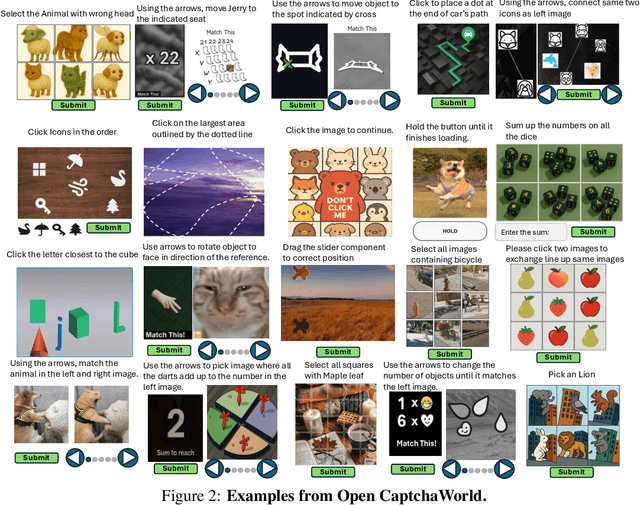
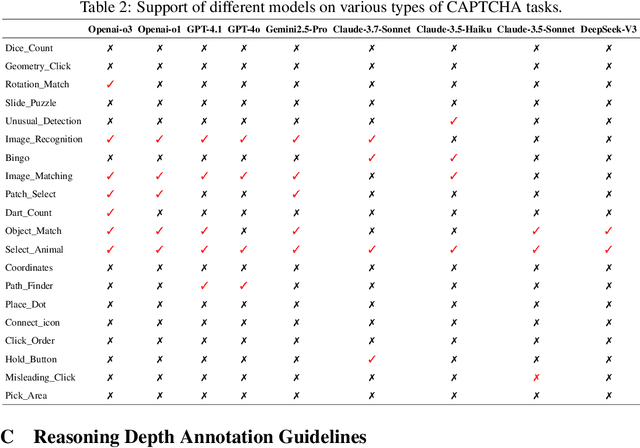
Abstract:CAPTCHAs have been a critical bottleneck for deploying web agents in real-world applications, often blocking them from completing end-to-end automation tasks. While modern multimodal LLM agents have demonstrated impressive performance in static perception tasks, their ability to handle interactive, multi-step reasoning challenges like CAPTCHAs is largely untested. To address this gap, we introduce Open CaptchaWorld, the first web-based benchmark and platform specifically designed to evaluate the visual reasoning and interaction capabilities of MLLM-powered agents through diverse and dynamic CAPTCHA puzzles. Our benchmark spans 20 modern CAPTCHA types, totaling 225 CAPTCHAs, annotated with a new metric we propose: CAPTCHA Reasoning Depth, which quantifies the number of cognitive and motor steps required to solve each puzzle. Experimental results show that humans consistently achieve near-perfect scores, state-of-the-art MLLM agents struggle significantly, with success rates at most 40.0% by Browser-Use Openai-o3, far below human-level performance, 93.3%. This highlights Open CaptchaWorld as a vital benchmark for diagnosing the limits of current multimodal agents and guiding the development of more robust multimodal reasoning systems. Code and Data are available at this https URL.
Uni4D: A Unified Self-Supervised Learning Framework for Point Cloud Videos
Apr 07, 2025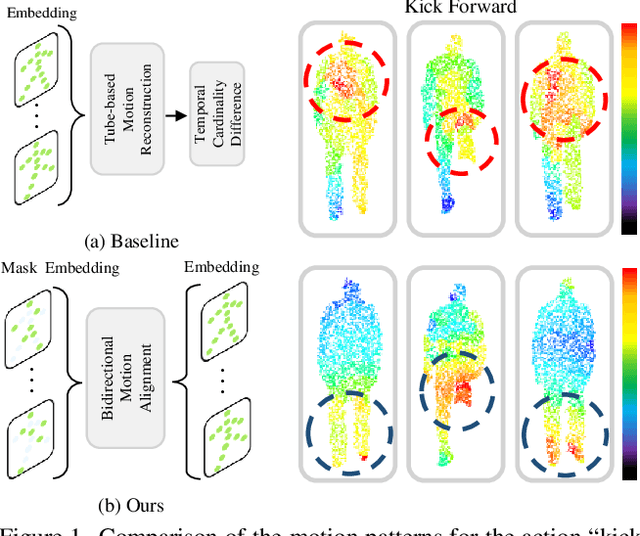
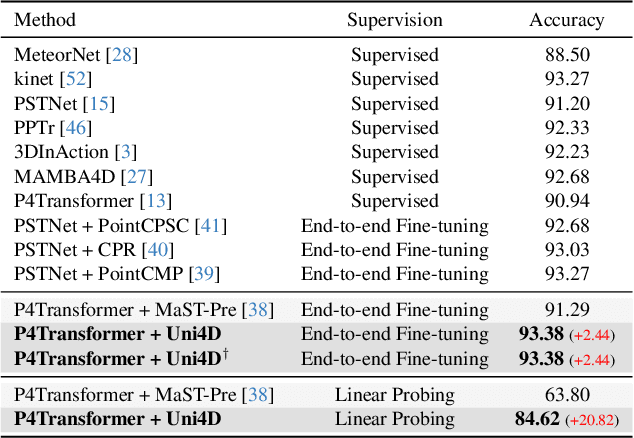
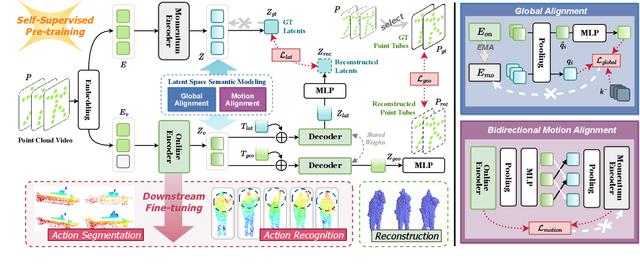
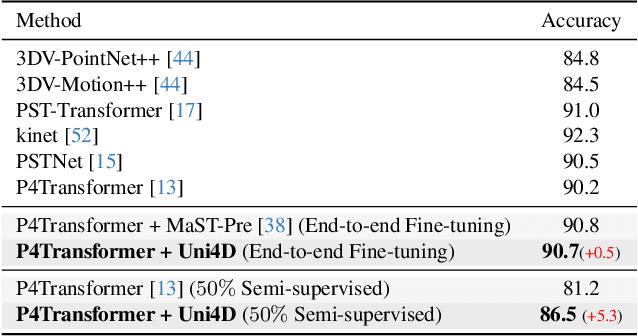
Abstract:Point cloud video representation learning is primarily built upon the masking strategy in a self-supervised manner. However, the progress is slow due to several significant challenges: (1) existing methods learn the motion particularly with hand-crafted designs, leading to unsatisfactory motion patterns during pre-training which are non-transferable on fine-tuning scenarios. (2) previous Masked AutoEncoder (MAE) frameworks are limited in resolving the huge representation gap inherent in 4D data. In this study, we introduce the first self-disentangled MAE for learning discriminative 4D representations in the pre-training stage. To address the first challenge, we propose to model the motion representation in a latent space. The second issue is resolved by introducing the latent tokens along with the typical geometry tokens to disentangle high-level and low-level features during decoding. Extensive experiments on MSR-Action3D, NTU-RGBD, HOI4D, NvGesture, and SHREC'17 verify this self-disentangled learning framework. We demonstrate that it can boost the fine-tuning performance on all 4D tasks, which we term Uni4D. Our pre-trained model presents discriminative and meaningful 4D representations, particularly benefits processing long videos, as Uni4D gets $+3.8\%$ segmentation accuracy on HOI4D, significantly outperforming either self-supervised or fully-supervised methods after end-to-end fine-tuning.
 Add to Chrome
Add to Chrome Add to Firefox
Add to Firefox Add to Edge
Add to Edge